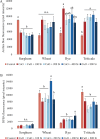Species-specific modulation of nitro-oxidative stress and root growth in monocots by silica nanoparticle pretreatment under copper oxide nanoparticle stress
- PMID: 39948461
- PMCID: PMC11823027
- DOI: 10.1186/s12870-025-06193-7
Species-specific modulation of nitro-oxidative stress and root growth in monocots by silica nanoparticle pretreatment under copper oxide nanoparticle stress
Abstract
Background: Abiotic stressors such as heavy metals and nanoparticles pose significant challenges to sustainable agriculture, with copper oxide nanoparticles (CuO NPs) known to inhibit root growth and induce oxidative stress in plants. While silica nanoparticles (SiO2 NPs) have been shown to increase abiotic stress tolerance, their role in mitigating CuO NP-induced stress in crops, especially monocots, remains poorly understood. This study addresses this critical knowledge gap by investigating how SiO2 NP pretreatment modulates CuO NP-induced stress responses, with a particular focus on root growth inhibition and nitro-oxidative stress pathways.
Results: Using an in vitro semihydroponic system, seeds were pretreated with varying concentrations of SiO2 NPs (100-800 mg/L) before exposure to CuO NPs at levels known to inhibit root growth by 50%. SiO2 NP pretreatment alleviated CuO NP-induced root growth inhibition in sorghum, wheat, and rye but intensified it in triticale. These responses are associated with species-specific alterations in reactive signaling molecules, including a reduction in nitric oxide levels and an increase in hydrogen sulfide in sorghum, a decrease in superoxide anion levels in rye, and elevated hydrogen peroxide levels in wheat. Protein tyrosine nitration, a marker of nitro-oxidative stress, was reduced in most cases, further indicating the stress-mitigating role of SiO2 NPs. These signaling molecules were selected for their established roles in mediating oxidative and nitrosative stress responses under abiotic stress conditions.
Conclusions: SiO2 NP pretreatment modulates CuO NP-induced stress responses through species-specific regulation of reactive oxygen and nitrogen species, demonstrating its potential as a tool for enhancing crop resilience. These findings advance the understanding of nanoparticle‒plant interactions and provide a foundation for future applications of nanotechnology in sustainable agriculture.
Clinical trial number: Not applicable.
Keywords: Copper oxide and silica nanoparticles; Monocotyledons; Nitro-oxidative stress response; Root growth inhibition; Species-specific response.
© 2025. The Author(s).
Conflict of interest statement
Declarations. Ethics approval and consent to participate: Not applicable. Consent for publication: Not applicable. Competing interests: The authors declare no competing interests.
Figures







References
-
- Grieger KD, Hansen SF, Baun A. The known unknowns of nanomaterials: describing and characterizing uncertainty within environmental, health and safety risks. Nanotoxicology. 2009;3(3):222–33.
-
- Zhang L, Fang M. Nanomaterials in pollution trace detection and environmental improvement. Nano Today. 2010;5(2):128–42.
-
- World Health Organization. FAO/WHO expert meeting on the application of nanotechnologies in the food and agriculture sectors: potential food safety implications: meeting report. World Health Organization; 2010.
-
- Safiuddin M, Gonzalez M, Cao J, Tighe SL. State-of-the-art report on use of nanomaterials in concrete. Int J Pavement Eng. 2014;15(10):940–9.
-
- Liu R, Lal R. Potentials of engineered nanoparticles as fertilizers for increasing agronomic productions. Sci Total Environ. 2015;514:131–9. - PubMed
MeSH terms
Substances
LinkOut - more resources
Full Text Sources
Miscellaneous

